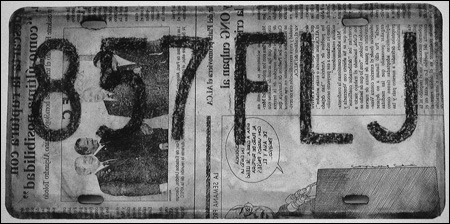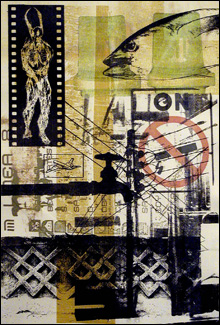
A TASTE OF DISLOCATION: Rafael Charco’s Migrantes III.
|
Thematically and stylistically varied, “Pulsiones Oscilantes (Oscillating Impulses)” is a touring exhibition of work by 21 Mexican printmakers. On view is a sample of what is being produced in one particular academic art environment, the School of Arts of the Universidad Autonoma del Estado de Mexico, in Toluca, where these artists were trained or still teach.
The Roman Catholic Church probably has inadvertently produced more artists in Mexico than priests and nuns. In The Seven Capitals (as in capital sins), Layla Cora presents seven monochrome depictions of the objectionable activities, assembled in the form of a cross. But there is not a lot of such religious iconography in this show, indicating either that the effects of religious upbringing on these artists have been too benign to require working out or, more likely, that skulls and crosses have become visual stereotypes through overuse.
Nevertheless, Ana Lilia Maciel tries, with only partial success, to elbow her way through triteness with La Tentación (The Temptation). Two small, red serpents writhe in convolutions echoed by the lengthy keychain that encloses them. Above them is a garish bat-winged and Kiss-tongued devil; below him a naked male and female facing each other from separate television screens. The successful part is the television cages. In a companion piece by Maciel, El Placer (The Pleasure), there likewise is no irony, this time with a fully clothed couple chastely kissing. Strangely naïve inclusions.
The questions that most artists ask ignore language and borders. Yet occasionally a work here signifies more because of where the artist is from. Three selections from the Migrants series by Rafael Charco show license plates, two tightly covered with newspaper. They are visually more interesting than that sounds, especially since the English-language newsprint is backwards, giving us a taste of the dislocation that an immigrant experiences in a country where he’s suddenly illiterate.
ADVERTISEMENT
 |
An inexhaustible supply of evocative imagery exists in the natural world, especially when placed in mythic context, of which Mexico has plenty. Héctor Mercado’s Romance de la luna (Romance of the Moon) depicts a coyote lapping at water amidst birds and fish in a richly textured monotype awash with moonglow yellow. The angular stylization of the suspended creatures reminds us of Mayan and Incan temple carvings. Few images in this show have indigenous inspiration, though. Nevertheless, this is a wide world, and sources for inspiration can range far: an African mask can be seen in the distorted face of José Luis Franco Arias’s Faceta I (Facet).

PILING ON THE IMAGES: Villalbazo’s Urban Book 3.
|
Nowadays, our eyes are incessantly assaulted from countless sources, so it’s ironic that artworks often pile on the images, not only to pass comment on the hubbub but also to help us transcend the welter. Alejandro Villalbazo’s Urban Book 3 pays homage to Robert Rauschenberg, incorporating one of his signature airplanes amidst a visual cacophony: fish and faucet, a no-smoking symbol, and human figures scratched onto a black strip of film.
Sometimes confusion is part of the message. The small, packed black-and-white engraving by José Luis Sánchez Rull, Antojito hide, is a freeze-frame from a dystopian world dripping and oozing with puzzling organic forms amidst such debris as discarded tires and broken crosses. Sometimes the artist helps us out, as when José Luis Vera separates the 10 small components of País (Country) into rows of bite-size digitally manipulated prints, ranging from pure abstractions to representational figures.
In the hands of a master, a multiplicity of images can offer the surprise of serenity, through composition that guides our eyes to resting places that are refuges from the surrounding storm. It doesn’t hurt that Édgar Miranda’s El arriba con el abajo (Up with down) is exquisitely rendered. Graceful black-and-white faces and figures quote Gustav Klimt, just as another Art Nouveau celebrity, Aubrey Beardsley, is referred to in one of six Persian-miniature-style color drawings decorating the drawing. (Drolly, the Klimt is drained of color and the Beardsley acquires some, reversing their chosen media.)
Ramón Ramírez Guevara’s Recuerdo (Memory) is aptly placed around the gallery doorway. It consists of small, flattened, open cardboard boxes “containing” literal impressions: ink-stamp images, some of objects but most of human figures caught mid-action, such as taking an exaggerated step or raising arms in surprise or alarm. What an original invitation: to walk through the door after seeing this show and notice what is contained in the fully dimensional world that art brings us to.
’PULSIONES OSCILANTES [OSCILLATING IMPULSES]’ | RISD’S BENSON HALL GALLERY | 235 BENEFIT STREET, PROVIDENCE | THROUGH OCTOBER 6